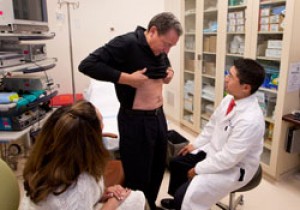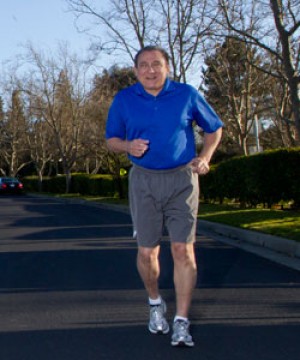Partnering Robotics and Humans to Perfect Prostate Cancer Care
Partnering Robotics and Humans to Perfect Prostate Cancer Care
…
Using Robotic Surgery to Remove Prostate Cancer at Stanford: Gil Khalil’s story
Gilbert Khalil’s fitness and bright eyes make it hard to believe he is 65. All that calm and confidence, however, took a big hit a year ago when his physician discovered trouble in the prostate gland. Khalil and his wife, Stacee, turned to Stanford Hospital, where robotic surgery performed by Mark Gonzalgo, MD, PhD, meant he was well and could return to his active life sooner than expected.
…
Gilbert Khalil has an enviable air of calm confidence and steady strength. His fitness and bright eyes make it hard to believe that he is 65. “I never smoked and I’ve been a firm believer in exercise—all the way since high school when I fell in love with competitive running—and I’ve worked out with weights,” he said.
He also understood that good health required more—managing stress. “That’s one of the things in our life that can really impact our wellness—stress is at the top of the list. It’s more difficult to measure, but I’ve always worked hard and smart so I could walk away from my job on the weekends.”
All that calm and confidence, however, took a big hit a year ago when his physician gave him the results of his annual PSA test, a measurement of blood proteins that in men signals trouble in the prostate gland. Khalil’s was elevated to a level that prompted his doctor to send him to a urologist, who did a tissue sample test that found a moderately aggressive form of cancer was indeed growing in Khalil’s prostate. “I never thought in my wildest dreams I would have cancer,” Khalil said. “My wife and I just sat there, struck by this bad news.”

Mark Gonzalgo, MD, PhD, director of Robotic-Assisted Urologic Cancer Surgery at Stanford (right), meets with Stacee and Gil Khalil.
Looking for Answers
That conversation was the trigger that sent Khalil on a serious search for answers. He had options, he found. Which one to choose was the question. The terrors of prostate cancer surgery, for instance, have long been incontinence and sexual dysfunction, caused by damage to crucial bundles of nerves near the prostate gland.
“I did a significant amount of due diligence,” he said. He had watched his mother endure a double mastectomy and suffer, struggling to come back from a surgery that, in her day, left grueling scars. More than a decade ago, his brother had surgery for prostate cancer and still fights its aftermath. With those examples before him, he said, he resolved he would find a way “to reduce the possibility of getting through this without such consequences.” Khalil was lucky in one respect: the cancer had been caught early.
“He laid out all the choices. He was very clear, very articulate.”
–Gilbert Khalil, patient, Stanford Hospital & Clinics
“If I had been 85,” he said, “I might have just waited it out.” Some prostate cancers are so slow growing that physicians and their patients may choose active surveillance, because of those surgical risks.
It took almost two months of reading. Khalil and his wife, Stacee, looked at everything from white papers to blogs to medical journal articles. There were other options besides surgery: Radiation and chemotherapy in various forms were available. “They all had consequences,” he said. “We decided we wanted to get a second or even a third opinion.” Then a friend suggested he talk to a surgeon at Stanford Hospital & Clinics. It turned out to be Mark Gonzalgo, MD, PhD, director of Robotic-Assisted Urologic Cancer Surgery at Stanford. Not only had Gonzalgo trained with one of the field’s most renowned innovators, he had more than 600 robotic procedures to his credit, using the very high-tech robotic-assist approach.
Gonzalgo also has done research on how to train surgeons on the da Vinci surgical system and has served as a mentor to other surgeons.

When Khalil and his wife, Stacee, first learned that Khalil had developed prostate cancer, they were stricken by the bad news. Then, they began a search for information that lead to Stanford and robotic-assisted surgery. “You go through this whole process of discovery,” Khalil said. “I couldn’t have done it without my wife by my side.”
Robots as Surgical Partners
Robotic devices are particularly useful for those laparoscopic procedures where angles are awkward and spaces tight. The robotic arms are only as precise, however, as the surgeon’s hands are sensitive. Gonzalgo physically maneuvers the machine’s long multi-jointed arms to connect them with instruments inserted through three shallow incisions into a patient’s abdomen. Then, he sits down at a console a few feet away and harnesses his thumb and forefinger into a joystick-like controller. He does not look across the room at the patient, but focuses his gaze through a scope that shows him a magnified, 3-D and high-definition quality view of his surgical target. Each exquisitely fine movement of his fingers and thumbs translates into robotic movement. At strategic points around the room are plasma monitors of that view that can be shared with the rest of the surgical team. “We have greater clarity,” Gonzalgo said, “and it’s much more comfortable to work together as a surgical team.”
…
WHAT YOU SHOULD KNOW ABOUT THE PROSTATE
The prostate is a gland, about the size of a walnut, just below the bladder and in front of the rectum. It produces part of the fluid in which semen travels. It improves sperm motility, survival and genetic integrity.
Prostate Cancer
Prostate cancer is the most common cause of cancer death for men over age 75. Since widespread screening began, more than 90 percent of prostate cancers are now diagnosed at an early stage. Some prostate cancers grow and spread quickly; others are so slow that other diseases will cause death before it does.Risks
• A diet high in animal fat
• Excessive alcohol consumption
• Father or brother with history of prostate cancer
• Over 60 years oldSymptoms
• Delayed or slow start of urinary stream
• Blood in urine or semen
• Straining while urinatingTests
• PSA (prostate-specific antigen) test: The higher the level, the higher the chance a cancer has grown. PSA levels are naturally higher in older men, but two conditions—benign prostatic hyperplasia and inflammation of the prostate—can also raise PSA levels. The PSA test alone is not enough to determine the presence of cancer.
• A digital rectal exam to check for bumps or abnormal areas.
• A doctor may also recommend a ultrasound, X-ray or cystoscopy.
• Finally, a sample of prostate tissue may be removed, usually with a needle.
• Risk factors determine when to begin PSA testing and how often to repeat the test. *Medicare covers an annual screening for men age 50 and up.Treatment
• Large incision surgery or robotic-assisted surgery and laparoscopy, conducted through small incisions, now widely accepted as an alternative to the traditional large incision surgery.
• Brachytherapy implants small radioactive seeds in the prostate.
• Some prostate cancers are responsive to hormonal therapy.
• Certain chemotherapy drugs can stop prostate cancer cell growth.
• Immunotherapeutic vaccines can work against prostate cancer using a patient’s own immune cells, removed from the body and triggered to recognize and destroy cancer cells.For more information about robotic-assisted urology surgery at Stanford Hospital & Clinics, visitstanfordhospital.org/prostatecancer or call 650.725.5544.
Gonzalgo explained all this to Khalil and his wife, in addition to discussing the other options, including surgery using a longer incision, without the robotic technology. “We met with him for about 45 minutes,” Khalil said. “He’d read all my reports and I told him about the history of cancer in my family. He laid out the choices. He was very clear, very articulate.”
“Robotic surgery can offer the advantage of less blood loss, less pain and a faster recovery because of the smaller incisions.”
–Mark Gonzalgo, MD, PhD, director of Robotic-Assisted Urologic Cancer Surgery at Stanford Hospital & Clinics
Khalil had also checked Gonzalgo’s background. “It was stellar,” he said. “I did a significant amount of research on the da Vinci and after that study, it was a no-brainer—we’d go with the robotic technology. It was, of all the procedures, the one I felt gave me the best chance of recovery, of saving the nerve endings.”
As many as four out of five radical prostatectomies in the United States are now performed with robotic assistance.
“Gil came to me as many do,” Gonzalgo said. “A very healthy patient, very health conscious, who wanted to explore all options. If a cancer is localized or low grade, a patient could be a candidate for active surveillance and that patient would not have to undergo the potential risks of radiation or surgery. But a lot of patients want the cancer removed from the body and robotic surgery can offer the advantage of less blood loss, less pain and a faster recovery because of the smaller incisions.”
“I started to feel good very quickly after the surgery. I was blown away at how fast I was able to recover.”
–Gilbert Khalil, patient, Stanford Hospital & Clinics
Gonzalgo also recommends that patients recognize that technology is only as valuable as the experience of those who wield it. “What’s most important is the actual surgeon and the surgical team performing the procedure. They should ask how many surgeries a surgeon has performed, where they trained, what kind of training it was. The art is in how adept the surgeon is in using the technology to remove the cancer and spare the patient side effects.”
Gonzalgo trained with the surgeon whose work brought a new understanding of the importance of how to approach the prostate to minimize side effects that can be caused if the delicate neurovascular bundles near the prostate are damaged. Avoiding those, Gonzalgo said, “is a much safer way to operate,” he said.
Confidently Moving On
Khalil’s surgery took about three hours and he spent just one night in the hospital. “I started to feel good very quickly after the surgery,” he said. “It was almost surreal. I’d been through two months of discovery and painstaking discussion and then it was over. I was blown away at how fast I was able to recover. It’s really a testament to the technology today, to all the research that’s been done on cancer.”

Within six weeks of his surgery, the 65-year-old Khalil had begun to jog. He now runs at his former pace. He credits his overall fitness to a lifelong habit of exercise, healthy eating and managing stress.
He felt so good he was back at work in three weeks and at six, he was starting to jog. Three months later, new tests showed he was free of his cancer and none of those universally-feared side effects of his surgery took place. “Everything is working!” he said.
“The key is catching the cancer early and doing something about it early,” Khalil said. “Some men say, ‘I’m going to roll the dice,’ and I can understand that. I was just so confident in everything I found at Stanford; I knew the outcome was going to be positive.”
His decades-long dedication to exercise played a big part, too, he said. “There is a pay-off to maintaining your weight and not being sedentary. And it’s never too late!”
About Stanford Hospital & Clinics
Stanford Hospital & Clinics is known worldwide for advanced treatment of complex disorders in areas such as cardiovascular care, cancer treatment, neurosciences, surgery, and organ transplants. It is currently ranked No. 17 on the U.S. News & World Report’s “America’s Best Hospitals” list and No. 1 in the San Jose Metropolitan area. Stanford Hospital & Clinics is internationally recognized for translating medical breakthroughs into the care of patients. The Stanford University Medical Center is comprised of three world renowned institutions: Stanford Hospital & Clinics, the Stanford University School of Medicine, the oldest medical school in the Western United States, and Lucile Packard Children’s Hospital, an adjacent pediatric and obstetric teaching hospital providing general acute and tertiary care. For more information, visit http://stanfordhospital.org/
###
* Stanford University Medical Center integrates research, medical education and patient care at its three institutions – Stanford University School of Medicine, Stanford Hospital & Clinics and Lucile Packard Children’s Hospital.
** The above story is adapted from materials provided by Stanford University School of Medicine
________________________________________________________________




















